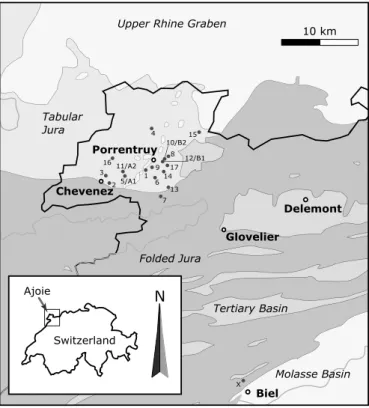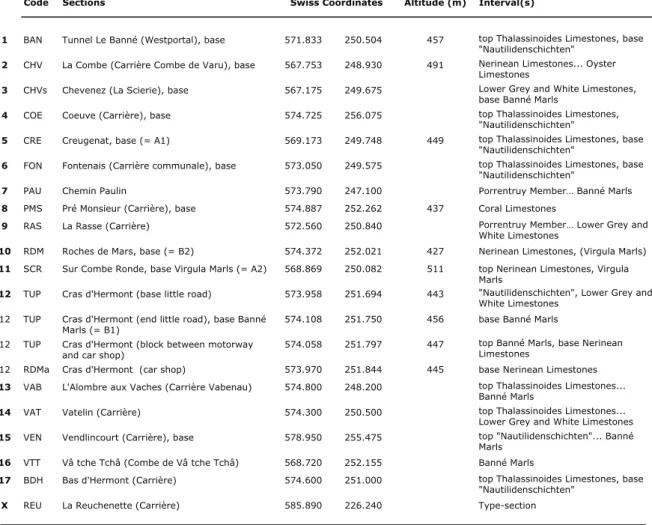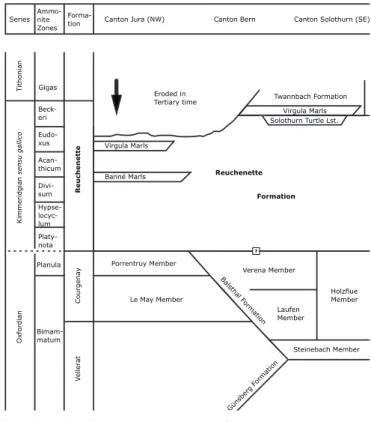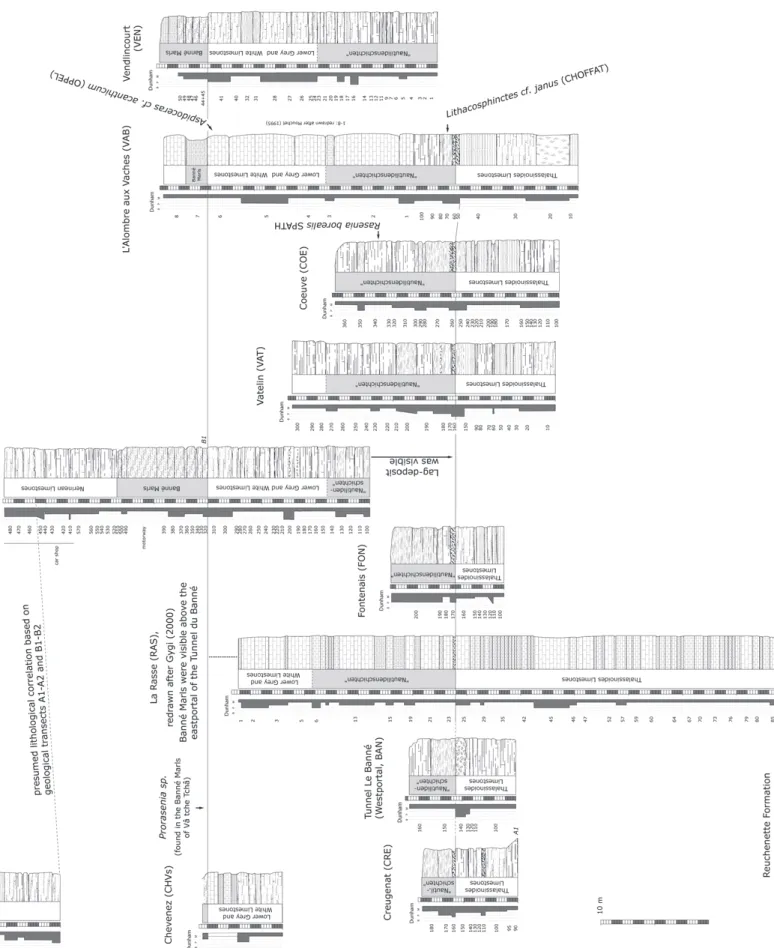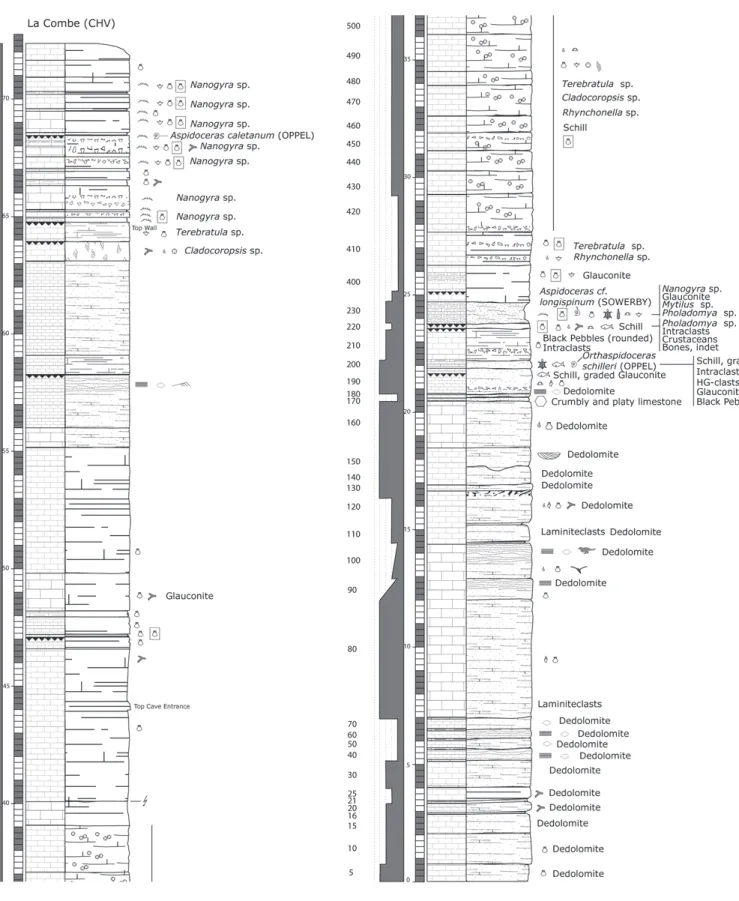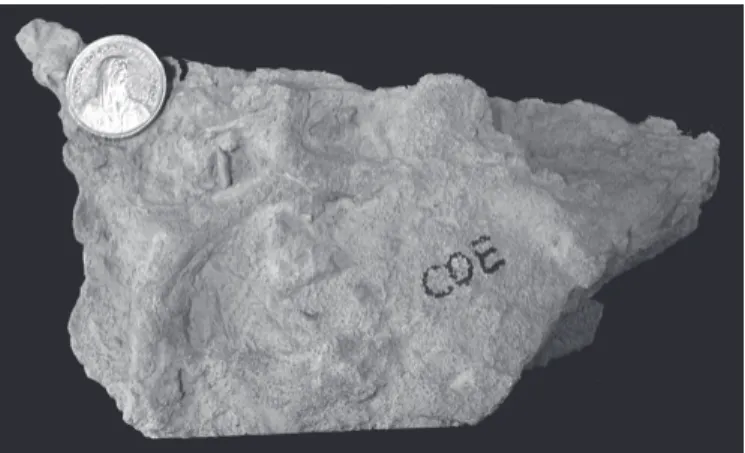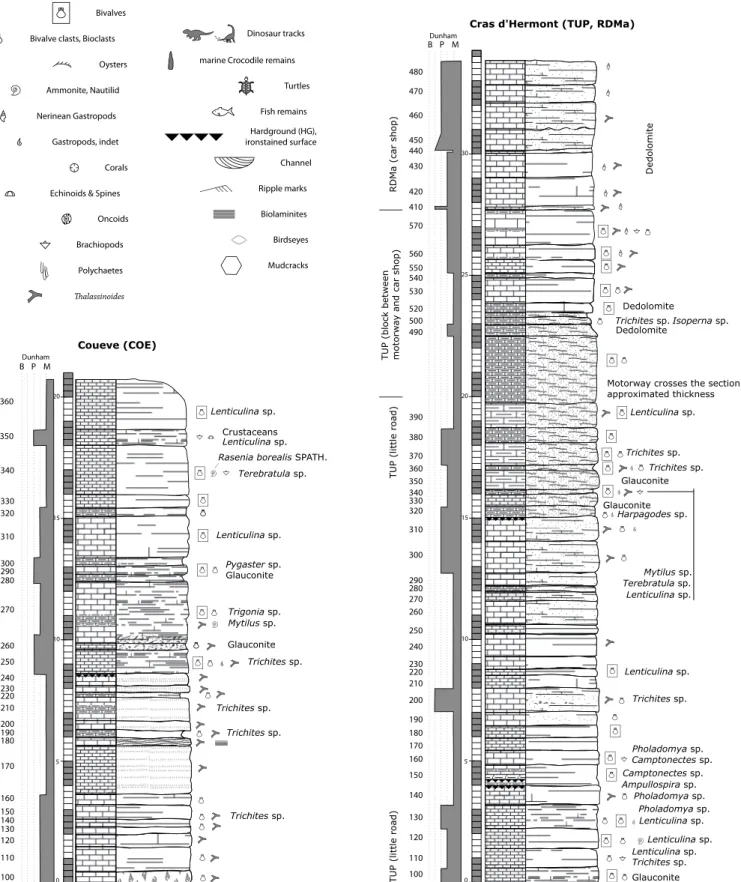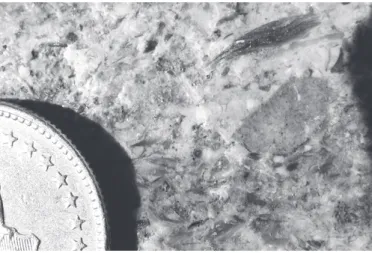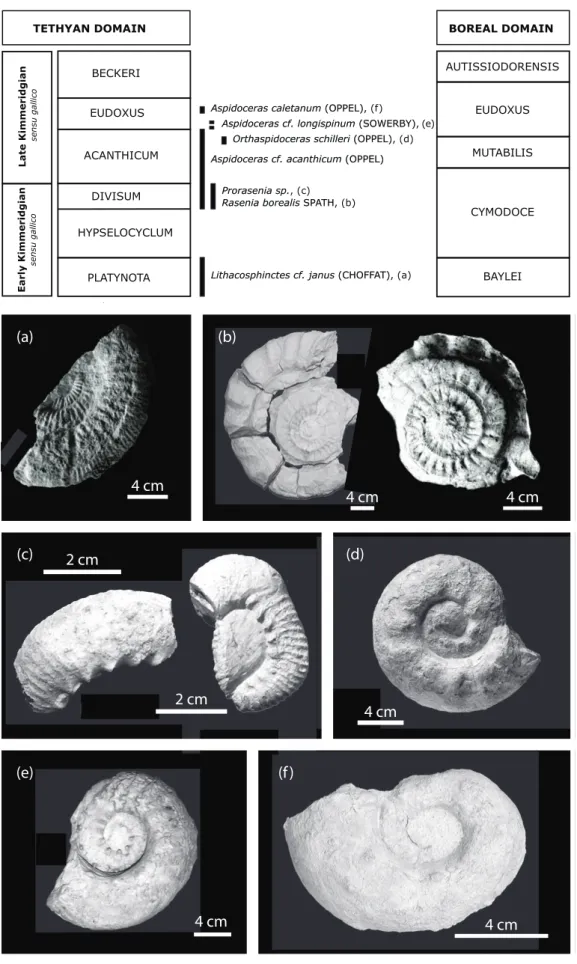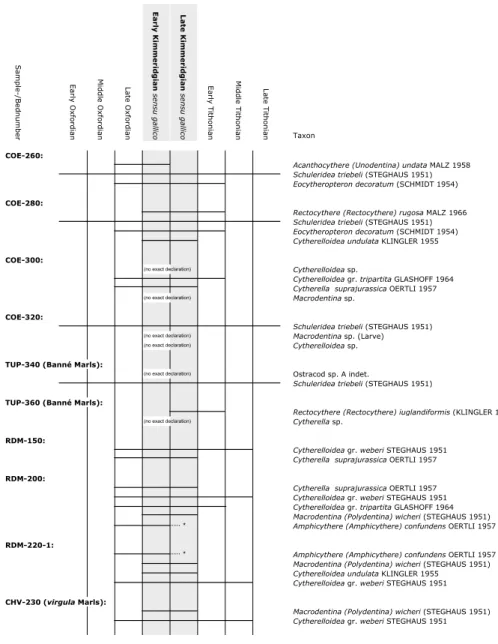A calibrated composite section for the Late Jurassic Reuchenette
Formation in northwestern Switzerland
(?Oxfordian, Kimmeridgian sensu gallico, Ajoie-Region)
M
ARKUSJ
ANK1, A
NDREASW
ETZEL2& C
HRISTIANA. M
EYER3Key words. Stratigraphy, biostratigraphy, Kimmeridgian, Jurassic, NW Switzerland, Banné Marls, Virgula Marls, Reuchenette Formation
ABSTRACT
A new stratigraphical frame for Kimmeridgian sediments of northwestern Switzerland has been established by correlating seventeen closely spaced sec-tions by means of lithological, sedimentological, and microfacial data as well as by ammonites. This newly established stratigraphical frame is of great value, because these sediments are usually characterised by a prominent sparseness of index-fossils (i.e. ammonites).
The biostratigraphical frame is based on seven species of ammonites and corroborated by ostracodes. The investigated sedimentary record is divided into nine intervals and assigned to the Late Oxfordian to Late Kimmeridgian
sensu gallico (middle Eudoxus-Zone). Exact lithological correlations between
the outcrops are achieved by three marker beds.
The new stratigraphical frame is a pre-requirement for refining correla-tions of seccorrela-tions, for reconstructing sea level fluctuacorrela-tions, and for quantifying synsedimentary differential subsidence.
ta, and to assign their age (e.g. Thurmann 1832; Greppin 1870; Häfeli 1966, Thalmann 1966; Chevallier 1989; Meyer C.A. 1989; Gygi 2000b). As ammonites are rare in shallow-water platform carbonates that accumulated mainly in a restricted setting, correlation over small distances relies on lithology. Re-cently, sequence-, cyclo- and mineralo-stratigraphy were used in addition for correlation (Gygi & Persoz 1986; Gygi 1995; Mouchet 1995, 1998; Gygi et al. 1998; Meyer M. 2000; Colom-bié 2002). These studies, however, are based on only a few reli-able high-resolution biostratigraphical markers, most of them unfortunately occurring in distant and/or small outcrops and/or have different biostratigraphical resolution and ages. There-fore, a precise high-resolution chronostratigraphical correla-tion over larger distances is difficult to establish. The age as-signment of Kimmeridgian platform sediments was attempted by benthic foraminifera (Tschudin 2001) and by the very rare ammonites (Gygi 1995, 2000b).
Therefore, a reliable biostratigraphical framework for Kimmeridgian sediments in NW Switzerland is still lacking with all consequences for their correlation.
Introduction
The thickness of the Reuchenette Formation in the southern and central Jura Mountains in northwestern Switzerland varies from about 40 m in the region of Solothurn (Gygi & Persoz 1986; Meyer C. A. 1993) to about 160 m in the region of Biel (quarry La Reuchenette near Péry BE; Thalmann 1966). Re-cent investigations of Mesozoic sediments in the Jura Moun-tains show, or at least suggest, that depo-centres migrated with time and that thickness variations are spatially related to Permo-Carboniferous subcrop structures, which probably be-came reactivated (Gonzalez 1993; Wetzel et al. 1993, 2003; Allia 1996; Burkhalter 1996; Pittet 1996; Allenbach 2002).
The Reuchenette Formation was introduced by Thalmann (1966) to replace the Kimmeridgian auctorum without chang-ing its boundaries and “fixchang-ing” the sediments biostratigraphi-cally. Consequently, the rarity of index-fossils within the Reuchenette Formation – even the type-section in the quarry La Reuchenette near Péry BE (No. X in Fig. 1) does not yield any index-fossils – led to numerous, but different suggestions as how to subdivide the sediment column, to correlate the
stra-1Markus Jank, Geologisch-Paläontologisches Institut Universität Basel, Bernoullistrasse 32, CH-4056 Basel, Switzerland. E-mail: janmar@gmx.ch 2Andreas Wetzel, Geologisch-Paläontologisches Institut Universität Basel, Bernoullistrasse 32, CH-4056 Basel, Switzerland.
E-mail: andreas.wetzel@unibas.ch
3Christian A. Meyer, Naturhistorisches Museum Basel, Augustinergasse 2, CH-4001 Basel, Switzerland. E-mail: christian.meyer@bs.ch
0012-9402/06/020175-170012-9402/06/02■■■-■■
DOI 10.1007/s00015-006-1187-8 Birkhäuser Verlag, Basel, 2006
Since the beginning of the Transjurane motorway project, new large outcrops in the Ajoie-Region expose the shallow-water limestones of the Reuchenette Formaton very well. The exposures are closely spaced and perfectly suited to study these sediments, and they contain index-fossils. It is the pur-pose of this paper to provide a general lithological and a re-fined/precise biostratigraphical frame for the sediments of the Reuchenette Formation in the Ajoie-Region by means of lithological, sedimentological, and microfacial data and by os-tracodes and in situ collected ammonites. The new biostrati-graphical framework is essential for the Jura Mountains and adjacent areas as it allows the evaluation of existing and re-cent data.
Geological Setting
The study area is located at the transition from the Folded Jura Mountains to the Tabular Jura of northwestern Switzerland (Ajoie-Region; Fig. 1). During the Late Jurassic, the area was covered by a shallow epicontinental sea between the Tethys in the south and the Paris Basin in the north and northwest (e.g. Ziegler 1990). Under subtropical conditions (e.g. Frakes et al. 1992) mainly carbonates and some marls accumulated on the Kimmeridgian platform. The development in the Thitonian, Portlandian and Cretaceous is poorly known, because during the Tertiary, or probably even before, the study area was sub-jected to weathering and erosion that removed the uppermost Late Kimmeridgian deposits; it is not known how much has been eroded.
In the Ajoie-Region the shallow-water limestones of the Reuchenette Formation rest on the Courgenay Formation (Fig. 2). The top of the Courgenay Formation (Porrentruy Member sensu Gygi 1995) consists of massive, white, chalky limestones (Gygi 1995, 2000b). The top of the Reuchenette Formation is eroded and overlain by Tertiary sediments. In the southern and central Jura Mountains, the Reuchenette Forma-tion is composed of well-bedded, grey and white limestones. They rest on the Balsthal Formation and are followed by the Twannbach Formation. The top of the Balsthal Formation (Verena Member sensu Desor & Gressly 1859; in Gygi 2000c) is composed of oo-oncolitic carbonates and grades laterally into the sediments of the Porrentruy Member (Fig. 2). The Twannbach Formation consists of cm-dm thick layers of dark-grey micritic limestones (Thalmann 1966).
Thalmann (1966) defined the Reuchenette Formation in the limestone quarry of La Reuchenette near Péry BE as a monotonous succession of bedded limestones with few and thin marl intercalations. Lime mudstone (sensu Dunham 1962) is the dominant lithology there, but peloidal wacke- to grastones and some oolitic horizons occupy some prominent in-tervals. Coral biostromes are uncommon (Gygi & Persoz 1986). The base of the Reuchenette Formation is marked by an uneven erosion surface (Thalmann 1966) overlain by a mas-sive 18 m thick limestone unit (Gygi & Persoz 1986). Locally a horizon with blackened lithoclasts is developed in the basal
lower part (Gygi 1982, Colombié 2002). The lower 8 m of this massive unit are composed of oo-oncolitic carbonates (Verena facies). The upper 10 m are primarily mudstone with local patches of oolitic wackestone. Above this massive limestone unit, well-bedded mudstones and peloidal wacke-to grain-stones with two bands of fenestrate stromatolites occur (Gygi 1982, Colombié 2002). The boundary between the massive unit and well-bedded limestones is conspicuous and it can be easily observed, whereas the horizon with blackened lithoclasts is re-stricted to a small part of the La Reuchenette quarry (Gygi & Persoz 1986). This sharp lithological contrast is developed be-tween the underlying members (i.e. Porrentruy and Verena Member) and the Reuchenette Formation in all sections in the Ajoie-Region and southern and central Jura Mountains (Gygi 2000b, c). For this reason, Gygi defined the boundary between the Reuchenette Formation and the underlying Balsthal and Courgenay Formation at the base of the well-bedded lime-stones (Gygi 2000b, c). This boundary is visible in the quarry La Rasse south of Porrentruy (Section RG 340 of Gygi, Gygi 2000b, No. 9 in Fig. 1) and in Chemin Paulin near Courgenay (Section RG 350 of Gygi; Gygi 2000b, No. 7 in Fig. 1). The thickness of the Reuchenette Formation in terms of Gygi’s boundaries is approximately 140 m at the type-section La Reuchenette.
Fig. 1. Geological overview map and Swiss coordinates of locations and geo-logical transects. Note the altitude difference (about 60 m) between the base of Coregent (A1) and the base of the Virgule Marls (A2) in Sur Combed Ronde (note: layers are ± horizontal; see Swiss geol. map 1085 St-Ursanne).
Delemont Biel Porrentruy Chevenez Glovelier 1 2 3 16 4 5/A1 6 7 8 9 10/B2 11/A2 12/B1 13 14 17 15 X Ajoie Switzerland N 10 km
Upper Rhine Graben
Tabular Jura
Folded Jura
Molasse Basin Tertiary Basin
Methods and Material
Seventeen outcrops were studied for their lithological, sedi-mentological, and facies record (Fig. 1). Twelve outcrops were measured and sampled in detail for polished slabs and thin sections.
The evaluation of the Standard Microfacies Types and the facies (Fig. 3) of approximately 500 thin sections are based on the classifications of Dunham (1962), Wilson (1975), and Flügel (1982). The interpretations of thin sections and deposi-tional environments are illustrated by “Facies-Patterns” on the right column of the figures. The term “bedding” is used to describe the internal characteristics/composition of a bed, e.g. flaser bedding, nodular bedding, cross bedding, laminated. The term “layering” is used to characterize the thickness of a bed, e.g. massive-layered (>1 m), thick-layered (0.3–1 m), thin-layered (1–3 dm), very thin-layered (<1 dm). Two geo-logical transects (see Fig. 1; A1-A2, B1-B2) were evaluated to obtain an independent information about the regional trends in thickness.
Ammonites were collected by M. Jank, B. Hostettler (Fon-dation Paléontologique Jurassienne) and the Section de
Paléontologie de la République et du Canton Jura (SPA). The taxonomic assignment was made by G. Schweigert (Staatliches Museum für Naturkunde, Stuttgart; Schweigert et al., in prep.). Ten marl samples were dissolved in H2O2and ostracodes were collected from the outwash samples (fractions between 100 and 400 µm) in order to obtain an independent age-control. U. Schudack (Berlin, Germany) made the taxonomic determina-tion and biostratigraphical interpretadetermina-tion.
The sections of La Rasse (No. 9 in Fig. 1) and Chemin Paulin (No. 7 in Fig. 1) were already measured and briefly de-scribed by Gygi (2000b). Some of the data added in these pro-files consist of observations made on samples and field de-scriptions by Gygi, stored in the Natural History Museum Basel. The sections of La Rasse, Chemin Paulin and Bas d’Hermont (No. 17 in Fig. 1) were re-investigated to detect marker beds.
As the position of the boundary between the Courgenay Formation and the Reuchenette Formation is a matter of de-bate (Thalmann 1966; Gygi 2000b, c), this work follows Gygi (see above).
Fig. 1. Coninued
Code Sections Altitude (m) Interval(s)
1 BAN Tunnel Le Banné (Westportal), base 571.833 250.504 457 top Thalassinoides Limestones, base
"Nautilidenschichten"
2 CHV La Combe (Carrière Combe de Varu), base 567.753 248.930 491 Nerinean Limestones... Oyster
Limestones
3 CHVs Chevenez (La Scierie), base 567.175 249.675 Lower Grey and White Limestones,
base Banné Marls
4 COE Coeuve (Carrière), base 574.725 256.075 top Thalassinoides Limestones,
"Nautilidenschichten"
5 CRE Creugenat, base (= A1) 569.173 249.748 449 top Thalassinoides Limestones, base
"Nautilidenschichten"
6 FON Fontenais (Carrière communale), base 573.050 249.575 top Thalassinoides Limestones, base
"Nautilidenschichten"
7 PAU Chemin Paulin 573.790 247.100 Porrentruy Member… Banné Marls
8 PMS Pré Monsieur (Carrière), base 574.887 252.262 437 Coral Limestones
9 RAS La Rasse (Carrière) 572.560 250.840 Porrentruy Member… Lower Grey and
White Limestones
10 RDM Roches de Mars, base (= B2) 574.372 252.021 427 Nerinean Limestones, (Virgula Marls)
11 SCR Sur Combe Ronde, base Virgula Marls (= A2) 568.869 250.082 511 top Nerinean Limestones, Virgula
Marls
12 TUP Cras d'Hermont (base little road) 573.958 251.694 443 "Nautilidenschichten", Lower Grey and
White Limestones
12 TUP Cras d'Hermont (end little road), base Banné
Marls (= B1)
574.108 251.750 456 base Banné Marls
12 TUP Cras d'Hermont (block between motorway
and car shop)
574.058 251.797 447 top Banné Marls, base Nerinean
Limestones
12 RDMa Cras d'Hermont (car shop) 573.970 251.844 445 base Nerinean Limestones
13 VAB L'Alombre aux Vaches (Carrière Vabenau) 574.800 248.200 top Thalassinoides Limestones...
Banné Marls
14 VAT Vatelin (Carrière) 574.300 250.500 top Thalassinoides Limestones...
Lower Grey and White Limestones
15 VEN Vendlincourt (Carrière), base 578.950 255.475 top "Nautilidenschichten"... Banné
Marls
16 VTT Vâ tche Tchâ (Combe de Vâ tche Tchâ) 568.720 252.155 Banné Marls
17 BDH Bas d'Hermont (Carrière) 574.600 251.000 top Thalassinoides Limestones, base
"Nautilidenschichten"
X REU La Reuchenette (Carrière) 585.890 226.240 Type-section
The composite section has been subdivided into nine inter-vals (see Fig. 4) that are named by characteristic features such as colour, fracturing, marl content or fossil content (Plate 1).
Lithology
Most of the lithologies are difficult to differentiate in the field outside road cuts and quarries; in addition, intense weathering often obliterates the typical features. Consequently, in the dif-ferent outcrops the boundaries between the intervals are occa-sionally diffuse and changes are gradual. The upper four inter-vals are only visible in La Combe (Figs 4 and 5).
Porrentruy Member (top of the Courgenay Formation
sensu Gygi 1995):
In the Ajoie-Region, the Porrentruy Member is composed of smoothly fracturing, massive, white, calcarenitic and micrit-ic, chalky limestones with Nerinean gastropods, small oncoids and coated intraclasts (Fig. 6). The latter two occasionally dis-play brownish rims.
Thalassinoides Limestone (≈30 m) (Plate 1, a):
The Reuchenette Formation starts with monotonous, thick- to massive-layered (m-thick), well-bedded, bioturbated, grey, micritic limestones with some bioclasts and reddish brown or greyish, coarse-grained, pseudo-oolitic (mainly rounded intraclasts and peloids) pockets, patches and strings within a micritic matrix. Generally, macrofossils are rare. Thin-to thick-bedded layers fracture conchoidally and commonly contain abundant Thalassinoides. These burrows are often filled with the coarse-grained pseudo-oolitic material men-tioned above. Between 22 m and 30 m (composite section; Fig. 4) several conspicuous horizons with Thalassinoides are filled with coarse spary cement (beds VAT-150, VAT-20, COE-240, COE-170, COE-180, VAB-40, VAB-30, RAS-25; see Fig. 4). Bed surfaces are often iron stained, occasionally bored and biogenically encrusted by oysters. About 9 m below the upper boundary of this interval, a 6–7 meters thick, white, chalky limestone with oncoids and coral clasts occurs within the mo-notonous, grey, micritic interval (e.g. beds RAS-45 to RAS-48; Fig. 4). In La Rasse another 3–4 m thick white layer is visible, intercalated into the grey limestones (beds 57 to RAS-60), as well. In Coeuve the top few meters bear a stromatolite layer.
“Nautilidenschichten” (≈11 m) (Plate 1, b):
The “Nautilidenschichten” form dm- to m-thick layers. They are strongly bioturbated, marly micritic limestones and limestones with weakly internal nodular bedding. The lower part tends to exhibit marl-limestone alternations when weath-ered; calcarenitic (probably storm-influenced) marly lime-stones alternate with bioturbated marly micritic background sediment. This interval contains a rich bivalve fauna and large nautilids (Cenoceras sp.). Locally, bored and biogenically en-crusted (by oysters) hardgrounds are intercalated. A signifi-cant 10–15 cm thick reddish brown storm lag deposit (beds
COE-260, VAT-160, VAB-50, RAS-24, PAU≈31; Fig. 4) with
strongly varying fossil content marks the boundary to the un-derlying interval (Figs. 7 and 8). This storm material is filled into Thalassinoides penetrating into the underlying bed. The upper part of the grey-coloured “Nautilidenschichten” is dom-inated by micrite and grades into the Lower Grey and White Limestones.
Lower Grey and White Limestones (≈11 m) (Plate 1, c): This interval is composed of dm-to m-thick layers of grey and white, micritic and calcarenitic limestones with blocky fractures. Thalassinoides burrows are rare. Occasionally, the top is composed of stromatolitic limestones. The interval is capped by a regional hardground, which bored and biogenical-ly encrusted by oysters.
Banné Marls (Banné Member sensu Marçou 1848; in Gygi 2000b, c) (≈8–9 m) (Plate 1, d):
The slightly nodular Banné Marls comprise grey dm-thick layers of marlstones, calcarenitic marls and marly limestones
Fig. 2. Chrono-, litho- and biostratigraphical scheme for the Reuchenette For-mation, based on data from Gygi (2000b), Meyer C.A. (1990, 1993) and this study. Arrow indicates position of the measured sections. The biostratigraphi-cal position of the lithologibiostratigraphi-cal boundary between the Reuchenette Formation and the Courgenay/Balsthal Formation is not proved; even the lithological boundary itself is a matter of debate. The associated thickness-relation in the Ajoie- and Solothurn-Region and are not to scale (difference about 100 m; compare introduction and results).
? Forma-tion Series Ammo-nite Zones
Canton Jura (NW) Canton Bern Canton Solothurn (SE)
Reuchenette Courgena y Ve ller a t Twannbach Formation Günsberg Form ation Bals thal F orm ation Oxfordian K immeridgian sensu gallico Tithonian Planula Platy-nota Hypse- locyc-lum Divi-sum Acan-thicum Eudo-xus Beck-eri Gigas Le May Member Porrentruy Member Banné Marls Virgula Marls Solothurn Turtle Lst. Verena Member Laufen Member Holzflue Member Steinebach Member Eroded in Tertiary time Reuchenette Formation Bimam-matum Virgula Marls
with a rich fauna of bivalves associated with some brachiopods, nautilids, echinoids, vertebrate remains (e.g. turtles, marine crocodiles), Thalassinoides and very rare ammonites. Shelly and calcarenitic horizons, probably reworked and winnowed by storms, are intercalated and commonly separate the beds. Nerinean Limestones (≈33 m) (Plate 1, e):
The Nerinean Limestone interval starts with d to m-thick layers of grey, calcarenitic limestones (≈10 m; Fig. 9), fol-lowed by significant white, blocky fracturing, dm- to m-lay-ered, chalky, calcarenitic limestones with large gastropods (Nerineans) and stromatolite layers (see Fig. 4). To the top it grades into greenish weathered, glauconite-rich pack- and grainstones with lumachelle intercalations (Fig. 10). This part shows characteristic, strongly bored and biogenically encrusted (by oysters), regional hardgrounds and cephalopods lying on them (Fig. 5).
Virgula Marls (≈1 m) (Plate 1, f):
This characteristic marl interval bears a rich fauna of bi-valves and cephalopods but small oysters (Nanogyra sp.) dom-inate. Vertebrate remains are often found. The marls are dark grey and form cm- to dm-thick layers. These marls correspond to the Virgula Marls mapped by Laubscher (1963).
Coral Limestones (≈15 m) (Plate 1, g):
The basal part of this interval comprises a few meters of dm-thick layers of grey, micritic limestones and intercalated bored and encrusted hardgrounds (probably regional extent). The Coral Limestones “sensu stricto” form a massive (m-thick) unit composed of thin- to thick-layered, blocky fracturing, white, and chalky, micritic limestones with corals, terbratulid and red-brown rhynchonellid brachiopods separated by thin marl seams. The aragonitic coral skeletons were dissolved and the voids then filled with calcite (e.g. Bathurst 1971). The in-terval grades into the Upper Grey and White Limestones. Upper Grey and White Limestones (≈18 m):
This monotonous micritic interval exhibits m-thick layers. It is composed of three parts, whereas the middle part (beds CHV-1000 to 1200 in Figs. 4 and 5) is marly compared with the two other two parts. The limestones separate blocky with con-choidal surfaces. Fossils and Thalassinoides are sparse. A stro-matolitic limestone with ripples capped by a hardground (bio-genically encrusted by oysters) marks the top of this interval. Oyster Limestones (≈17 m) (Plate 1, h):
This interval starts with massive (m-thick), calcarenitic limestones and a layer yielding Cladocoropsis mirabilis
Fig. 3. Facies-types and depositional environments; Reuchenette Formation, Ajoie-Region.
Facies Bathymetry Depositional environment Facies association
Intraclastic pack- to grainstones (-layer) shallow subtidal to
intertidal
lagoon Thalassinoides and storm
sediment association
Lumachelle (shell bed) shallow subtidal to
intertidal
lagoon Thalassinoides and storm
sediment association Bioclastic mud- and wackestones (± in situ
macrofauna)
shallow subtidal open lagoon and open platform Open lagoon and bight
association
Chalky bioclastic mudstones with coral meadows shallow subtidal open lagoon or bight Open lagoon and bight
association Marly bioclastic wacke- to packstones and float- to
rudstones with in situ macrofauna
shallow subtidal protected lagoon or bight Open lagoon and bight
association Bioclastic wacke- and packstones with in situ
macrofauna (± argillaceous, slightly nodular)
shallow subtidal open lagoon, next to shell shoals Open lagoon and bight
association Oncoidal (chalky) wacke- to packstones and float-
to rudstones
(very) shallow subtidal
restricted and relatively quiet lagoon
Rerstricted lagoon association
Peloidal mud- to grainstones intertidal and
shallow subtidal
restricted, shallow lagoon and tidal flat
Rerstricted lagoon association
Non-laminated homogeneous micrite intertidal and very
shallow subtidal
tidal pond and protected, quiet, very shallow bight or lagoon
Rerstricted lagoon association
Lensoidal pack-/rudstone intertidal storm surge channel or rip channel
in a tidal flat environment
Rerstricted lagoon association
Laminated mudstones supratidal and
intertidal
restricted platform areas Supra- and intertidal
platform area association
Crumbly and platy mudstones and wackestones supratidal and
intertidal
mud flat or marsh deposit Supra- and intertidal
Fig. 4. Biostratigraphically subdivided composite overview for the sediments of the Reuchenette Formation in the Ajoie-Region. Detailed sections are published in PhD thesis of Markus Jank (Jank 2004).
(0–6 m). It is overlain by dm-thick layers of occasionally platy, marly, fine-grained (micritic) limestones, dominated by oysters.
Biostratigraphy
The biostratigraphical framework is provided by seven species of in situ collected ammonites (Fig. 11). Early Kimmeridgian sensu gallico is indicated by Lithacosphinctes cf. janus (CHOF-FAT), Rasenia borealis SPATH and Prorasenia sp. (micro-conche of the family Aulacostephanidae). Aspidoceras cf. acan-thicum (OPPEL) indicates the Divisum- and Acanacan-thicum- Acanthicum-Zone (pers. comm. G. Schweigert). Orthaspidoceras schilleri (OPPEL), Aspidoceras cf. longispinum (SOWERBY) and As-pidoceras caletanum (OPPEL) are indicative for the Acan-thicum- and Eudoxus-Zones (Late Kimmeridgian sensu galli-co). One specimen of Lithacosphinctes cf. janus (CHOFFAT) was found at the base of the “Nautilidenschichten” in L’Alom-bre aux Vaches (bed VAB-70; Fig. 4). One specimen of Rase-nia borealis SPATH occurred near the top of the “Nautiliden-schichten” in Coeuve (bed COE-340; Fig. 4). They indicate the Platynota-Zone and the Divisum-Zone. One specimen of Pro-rasenia sp. from the base of the Banné Marls in Vâ tche Tchâ also indicates the Divisum-Zone. The exact position of Aspi-doceras cf. acanthicum (OPPEL) is not clear, as Gygi & Persoz (1986) state that one specimen “was taken by H. and A. Zbinden from a block which fell presumably from a marly limestone 1,5 m below the Banné Marls” in L’Alombre aux Vaches (see also Gygi 1995). After Mouchet (1995), the speci-men is from the marly limestone 1,5 m below the Banné Marls in L’Alombre aux Vaches. Several specimens of Orthaspido-ceras schilleri (OPPEL) were found on hardgrounds and in glauconitic beds below the Virgula Marls (beds RDM-200, CHV-200, beds in Sur Combe Ronde around 5–8 m; Figs. 4 and 5), indicating the Schilleri-Horizon of the late
Acan-thicum-Zone. One specimen of Aspidoceras cf. longispinum (SOWERBY) was found within the Virgula Marls (bed CHV-230) and indicates the lowermost Eudoxus-Zone. Two speci-mens of Aspidoceras caletanum (OPPEL) point to the Cale-tanum-Horizon of the middle Eudoxus-Zone. One specimen was found in the Oyster Limestones in La Combe (bed CHV-3000), the other one in the lowermost beds of the Coral Lime-stones right above the Virgula Marls in Sur Combe Ronde (beds in Sur Combe Ronde around 9 m; Fig. 4).
Due to low biostratigraphical resolution, ostracodes only vaguely agree with the ammonite data. They merely indicate the Early or Late Kimmeridgian sensu gallico (Fig. 12). Fur-thermore, the correlation between the ammonite-zones and ostracodes is not adequately established and remains a point of discussion (e.g. Weiss 1995), as illustrated by the biostrati-graphical extension of ostracodes in beds RDM-200 and RDM-220 and the biostratigraphical position of Orthaspido-ceras schilleri (OPPEL) also found in bed RDM-200 (Figs. 4, 11 and 12). For example, Amphicythere (Amphicythere) con-fundens OERTLI was found in Roches de Mars (beds RDM-200, RDM-220) and it appears that it is not in contradiction to Orthaspidoceras schilleri (OPPEL) also found in bed RDM-200 because Schudack (1994) describes a (litho)stratigraphical extension for Amphicythere (Amphicythere) confundens OERTLI from “Mittlerer Korallenoolith bis Unter-Kim-meridge”, which corresponds approximately to the Mutabilis-Zone/parts of the Acanthicum-Zone (Weiss 1995, 1996, 1997; Gramann et al. 1997).
Results
The stratigraphical correlation of the sections (Fig. 4) was es-tablished by the combination of lithological, facies and sedi-mentological criteria in combination with biostratigraphical data. This is exceptional because it is the first time that a large
Fig. 6. White chalky limestone with angular and rounded intraclasts (bed RAS-88, La Rasse; scale: ∆≈2.5 cm).
Fig. 7. Storm-lag deposit (intraclastic pack- to grainstone) with cast
Thalassi-noides (bottom side, positive hypichnia) – Important marker bed (bed
Fig. 8. Sections Cras d’Hermont and Coeuve – Bed COE-260 is the storm-lag marker bed at the base of the “Nautilidenschichten”. Beds TUP-230 to TUP-510 is the Banné Marls. For legend see Fig. 4.
Birdseyes Mudcracks Ripple marks Channel Fish remains Biolaminites Turtles marine Crocodile remains
Dinosaur tracks
Gastropods, indet Nerinean Gastropods
Brachiopods Corals Echinoids & Spines
Bivalves Bivalve clasts, Bioclasts
Oysters
Oncoids
Polychaetes
Thalassinoides
Ammonite, Nautilid
Macrofossils & structures
Hardground (HG), ironstained surface 0 5 10 15 20 360 350 340 330 320 310 300 290 280 270 260 250 240 230 210 200 190 180 170 160 150 140 130 120 110 100 220 Lenticulina sp. Lenticulina sp. Crustaceans Lenticulina sp. Pygaster sp. Glauconite Trigonia sp. Mytilus sp. Trichites sp. Trichites sp. Trichites sp. Trichites sp. Terebratula sp. Rasenia borealis SPATH.
Glauconite Dunham Coueve (COE) P M B 480 470 460 450 440 430 420 410 570 560 550 540 530 520 500 490 390 380 370 360 350 340 330 320 310 300 290 280 270 260 250 240 230 220 210 200 190 180 170 160 150 140 130 120 110 100 Pholadomya sp. Camptonectes sp. Ampullospira sp. Trichites sp. Harpagodes sp. Mytilus sp. Trichites sp. Isoperna sp. Lenticulina sp. Glauconite Glauconite Glauconite Lenticulina sp. Lenticulina sp.
Motorway crosses the section: approximated thickness Trichites sp. Lenticulina sp. Lenticulina sp. Pholadomya sp. Pholadomya sp. Camptonectes sp. Dedolomite Dedolomite Dedolomite Trichites sp. Trichites sp. Terebratula sp. Lenticulina sp. Dunham P M B 0 5 10 15 20 25 30
RDMa (car shop)
TUP (block between motorw
a
y
and car shop)
TUP (little road)
TUP (little road)
composite section of the sediments of the Reuchenette Forma-tion can be biostratigraphically constrained by six bed-rock controlled ammonite occurrences (in situ collected).
Marker beds provide a lithological correlation between the outcrops. The sections Coeuve, La Rasse, L’Alombre aux Vaches, Vatelin, Creugenat, Fontenais, Chemin Paulin, Cras d’Hermont and Bas d’Hermont can be exactly correlated by the reddish brown, bioturbated, intraclastic wacke- to pack-stone storm-lag deposit at the base of the “Nautilidenschicht-en”. The Banné Marls connect the sections La Rasse, L’Alom-bre aux Vaches, Chemin Paulin, Vendlincourt, Vâ Tche Tchâ and Cras d’Hermont. The sections La Combe and Cras d’Her-mont are correlated by coarser grained equally thick, calcaren-tic limestone beds within the Nerinean Limestone interval composed of peloidal wacke- to packstones. The second marl intercalation (Virgula Marls) allows lithological correlations between the sections La Combe, Roches des Mars and Sur Combe Ronde. The laterally homogeneous facies distribution, the vertical facies stacking pattern and lithological changes within close outcrops support these correlations.
The lithological correlation of the Virgula Marls is substan-tiated by the occurrence of Aspidoceras cf. longispinum
(SOWERBY) and Orthaspidoceras schilleri (OPPEL) and some conspicuous hardgrounds (Fig. 5, beds CHV-190 to CHV-230). As indicated by Prorasenia sp. and Rectocythere (Rectocythere) iuglandiformis (KLINGLER), sedimentation of the Banné Marls at least started in the Divisum-Zone and probably continued in the Acanthicum-Zone. In the section La Combe Orthaspidoceras schilleri (OPPEL), Aspidoceras cf. longispinum (SOWERBY) and Aspidoceras caletanum (OPPEL) show that virgula-bearing sediments in the Jura Mountains differ in age. These ammonite finds also confirm that sediments between the Virgula Marls and Oyster Lime-stones are of Kimmeridgian age (Eudoxus-Zone) in the Ajoie-Region, as mentioned by Gygi et al. (1998), regarding Laub-scher’s “Portlandien” (Laubscher 1963). Furthermore am-monites show that at least three different virgula-bearing levels exist in the Swiss Jura Mountains: two in La Combe (Virgula Marls, Oyster Limestones) and one in the type-section of La Reuchenette, where they were deposited below the boundary to the Twannbach Formation (Thalmann 1966).
Considering the short time span covered by the Cale-tanum-Horizon, the enormous thickness of the Coral Lime-stones and Upper Grey and White LimeLime-stones, is interpreted to be related to an important gain in accommodation space, resulting from sea level rise and enhanced subsidence (Jank, 2004).
Due to the lack of biostratigraphical data, the age of the lithological boundary (sensu Gygi; see above) to the Porren-truy Member remains vague. It is most probably within the Late Oxfordian (Jank 2004).
The “Nautilidenschichten” correspond to the “thick limestone beds with a rich fauna of bivalves and large nau-tilids in the old quarry adjacent to Fontenais cemetery south of Porrentruy” (Fontenais; No. 6 in Fig. 1), the “succession above sequence boundary K1” in the quarry La Rasse (Gygi et al. 1998), as well with the lowermost part of the quarry
Fig. 9. Nerinean Limestones – Grey “sandy” limestone at the base of the Ner-inean Limestone interval (base La Combe). Presumed lithological correlation with top Cras d’Hermont.
Fig. 10. Schill layer – Reworked material (right centre) from base of bed CHV-190 in shell-supported matrix (top of bed CHV-190, above hardground, La Combe; scale: ∆≈2.5 cm).
Lithacosphinctes cf. janus (CHOFFAFF T)AA
Lithacosphinctes cf. janus (CHOFFAT), (a)
Rasenia borealis SPATHAA
Rasenia borealis SPATH, (b)
Prorasenia sp.
Prorasenia sp., (c)
Aspidoceras cf. acanthicum (OPPEL)
Aspidoceras cf. acanthicum (OPPEL)
Orthaspidoceras schilleri (OPPEL)i
Orthaspidoceras schilleri (OPPEL), (d)
Aspidoceras cf. longispinum (SOWERBY)
Aspidoceras cf. longispinum (SOWERBY), (e)
Aspidoceras caletanum (OPPEL)
Aspidoceras caletanum (OPPEL), (f)
Early Kimmeridgian
sensu gallico
Late Kimmeridgian
sensu gallico
TETHYAN DOMAIN BOREAL DOMAIN
PLATYNOTA HYPSELOCYCLUM DIVISUM ACANTHICUM EUDOXUS BECKERI AUTISSIODORENSIS EUDOXUS MUTABILIS CYMODOCE BAYLEI
4 cm
(f )
(e)
4 cm
4 cm
(d)
(c)
2 cm
2 cm
4 cm
4 cm
(b)
(a)
4 cm
Fig. 11. Biostratigraphical frame based on ammonites. Zonation of the Kimmeridgian sensu gallico after Hantzpergue et al. (1997). Tethyan Domain is used sensu Domaine Téthysien, Province subméditer-raneénne; Boreal Domain is used
sensu Domaine Boréal, Province
subboréale. All ammonites were collected in situ, except Aspidoceras cf. acanthicum (OPPEL) (Gygi 1995).
Exact biostratigraphical range and localities: (a) Lithacosphinctes cf.
janus (CHOFFAT); Platynota-Zone; L'Alombre aux Vaches. (b)
Rasenia borealis SPATH;
Divisum-Zone; Coeuve. (c) Prorasenia sp.; Divisum-Zone; Vâ tche Tchâ.
Aspi-doceras cf. acanthicum (OPPEL);
Divisum- to Acanthicum-Zone; L'Alombre aux Vaches. (d)
Or-thaspidoceras schilleri (OPPEL); Acanthicum-Zone, Lallierianum-Sub-Zone, Schilleri-Horizon; La Combe (top bed CHV-190; © SPA, photo by B. Migy), Roches de Mars and Sur Combe Ronde. (e)
Aspido-ceras cf. longispinum (SOWERBY);
lowermost Eudoxus-Zone; La Combe. (f) Aspidoceras caletanum (OPPEL); Eudoxus-Zone, Cale-tanum-Sub-Zone, Caletanum-Hori-zon; La Combe and Sur Combe Ronde (limestone about 1 m above the Virgula Marls; © SPA).
Vabenau (Mouchet 1995, 1998) (L’Alombre aux Vaches; No. 13 in Fig. 1).
The multi-faceted facies of the sediments of the Reuch-enette Formation in the Ajoie-Region represent an open to protected marine, very proximal platform setting within the Jurassic epicontinental realm of Central Europe. Facies, fauna and sedimentary structures are characteristic for shallow subti-dal to supratisubti-dal settings and allow the distinction of 12 facies-entities.
Thickness estimates between the storm lag deposit at the base of the “Nautilidenschichten” (Fig. 1; point A1), the base of the Banné Marls (Fig. 1; point B1) and the base of the Vir-gula Marls (Fig. 1; point A2 and point B2) on the geological transects A1-A2 and B1-B2 independently confirm the nesses given by correlations based on marker beds. The thick-ness between the base of the Reuchenette Formation and the base of the Banné Marls of section Chemin Paulin (Gygi
2000b) independently corroborates the thickness between the base of the Reuchenette Formation and the base of the Banné Marls measured by correlating La Rasse, Cras d’Hermont and L’Alombre aux Vaches.
Based on all these data the thickness of the sediments of the Reuchenette Formation preserved in the Ajoie-Region is about 140 m.
Discussion
The lithological correlations between the outcrops are in agreement with the biostratigraphical data. Nonetheless, the question arises, how reliable such lithological correlations are. Comparisons with modern environments are useful to illus-trate the precision of such correlations, if lateral extent of fa-cies belts, stacking patterns and event beds are considered.
Fig. 12. Biostratigraphical framework given by range of some ostracodes. Note range of ostra-code assemblage-zones vaguely agree with am-monite data. *Redrawn after Weiss (1995, 1996, 1997) and Gramann et al. (1997).
Sample-/Bednumber
Early Oxfordian Middle Oxfordian Late Oxfordian
Early Kimmeridgian
sensu gallico
Late Kimmeridgian
sensu gallico
Early Tithonian Middle Tithonian Late Tithonian
Taxon
COE-260:
Acanthocythere (Unodentina) undata MALZ 1958 Schuleridea triebeli (STEGHAUS 1951) Eocytheropteron decoratum (SCHMIDT 1954) COE-280:
Rectocythere (Rectocythere) rugosa MALZ 1966 Schuleridea triebeli (STEGHAUS 1951) Eocytheropteron decoratum (SCHMIDT 1954) Cytherelloidea undulata KLINGLER 1955 COE-300:
(no exact declaration) Cytherelloidea sp.
Cytherelloidea gr. tripartita GLASHOFF 1964 Cytherella suprajurassica OERTLI 1957
(no exact declaration) Macrodentina sp.
COE-320:
Schuleridea triebeli (STEGHAUS 1951)
(no exact declaration) Macrodentina sp. (Larve)
(no exact declaration) Cytherelloidea sp.
TUP-340 (Banné Marls):
(no exact declaration) Ostracod sp. A indet.
Schuleridea triebeli (STEGHAUS 1951)
TUP-360 (Banné Marls):
Rectocythere (Rectocythere) iuglandiformis (KLINGLER 1955)
(no exact declaration) Cytherella sp.
RDM-150:
Cytherelloidea gr. weberi STEGHAUS 1951 Cytherella suprajurassica OERTLI 1957 RDM-200:
Cytherella suprajurassica OERTLI 1957 Cytherelloidea gr. weberi STEGHAUS 1951 Cytherelloidea gr. tripartita GLASHOFF 1964 Macrodentina (Polydentina) wicheri (STEGHAUS 1951) * Amphicythere (Amphicythere) confundens OERTLI 1957 RDM-220-1:
* Amphicythere (Amphicythere) confundens OERTLI 1957 Macrodentina (Polydentina) wicheri (STEGHAUS 1951) Cytherelloidea undulata KLINGLER 1955
Cytherelloidea gr. weberi STEGHAUS 1951 CHV-230 (virgula Marls):
Macrodentina (Polydentina) wicheri (STEGHAUS 1951) Cytherelloidea gr. weberi STEGHAUS 1951
Investigations of recent shallow-marine carbonate systems show that lateral changes in facies may occur within ten’s of kilometres (e.g. Harris & Kowalik 1994), i.e. a specific facies shows lateral continuity of several kilometres, at least. For ex-ample, the carbonate mud facies on the Great Bahama Bank west of Andros Island occupies an area larger than 2700 km2 (30 km x 90 km); the pellet-mud facies an area of about 3600 km2 (Purdy 1963a, b). In the German Muschelkalk, Aigner (1985) demonstrated that depositional cycles mainly composed of event beds correlate over ten’s of kilometres. Modern tem-pestite deposits from Hurricane Kate (1985) are blanketing the peloidal packstone environment offshore of the Caicos tidal flat (Bahamas) (Wanless et al. 1988).
For the Ajoie-Region the facies imply that the platform topography can be considered as having been rather flat. The shallow-marine sediments probably built up close to sea level, filling accommodation space, which resulted in a generally flat topography. This in turn favoured a more or less uniform lat-eral facies development (i.e. no significant latlat-eral facies changes have been observed). In addition, deposition on a flat topography is highly sensitive to low-amplitude relative sea level fluctuations leading to deposition of widespread and nearly synchronous beds similar in lithology and stacking pat-tern (Strasser et al. 1999). As the outcrops in the Ajoie-Region are closely spaced within the range of kilometres the lithologi-cal correlations appear to be reliable, especially when com-pared to modern analogues. At least three easily identifiable marker beds can be traced and used for exact lithological correlations.
Conclusions
The investigations provide a data set improving the knowledge of the sedimentary history of the Reuchenette Formation in the Swiss and French Jura, because the Reuchenette Forma-tion was initiated by Thalmann (1966) to replace the Kim-meridgian auctorum.
The identification of the different depositional environ-ments within a very shallow epicontinental sea with periodic emersion, allows defining marker beds useful for lithological correlations of biostratigraphically dated intervals over small distances. The sections provide a composite overview of the sedimentary record during the (? Planula) Platynota- to the Eudoxus-Zones: nine lithological intervals, seven in situ col-lected species of ammonites, and several marker horizons. The preserved thickness of the investigated sediments in the Ajoie-Region is at least of 140 m. It is still a matter of debate if the uppermost beds can be correlated with the type-locality at La Reuchenette (Jank, 2004). The observations also show that the boundary with the Porrentruy Member (Courgenay Forma-tion) is still uncertain in terms of biostratigraphical age.
Nevertheless – taking into account that in situ index-fossils are very rare in the Kimmeridgian platform sediments of the Jura Mountains – this overview serves as a base for further re-fined investigations in terms of sea level fluctuations and
synsedimentary differential subsidence (thickness variations and movement of depo-centres) and it offers the possibility to compare the sediments with other biostratigraphically con-strained sections and outcrops in the Boreal and Tethyan realm.
Additional Information
Fossils of the beds CRE-160 and CRE-170 in Creugenat col-lected and determined during a palaeontological excavation field course by the Geologisch-Paläontologisches Institut Uni-versity of Basel (GPI) in collaboration with the SPA are docu-mented in the annual reports 2000 and 2002 of the SPA (“SPA” 2001; Marty 2003). The fossils found in the Banné Marls of Vâ Tche Tchâ and the Virgula Marls of La Combe are published in the annual reports of the SPA, as well (Marty & Diedrich 2002).
The taxonomic determination of several fossils is still under discussion: see forthcoming annual reports and publications of the SPA, diploma thesis at the GPI of K. Stransky (in prep.), S. Thüring (in prep.) and R. Waite (in prep.), and the huge and extraordinary collection of B. Hostettler (Fondation Paléon-tologique Jurassienne).
Apart from the sections Chemin Paulin, Bas d’Hermont, Vâ tche all sections can be found in the PhD thesis of Markus Jank (New insights into the development of the Late Jurassic Reuchenette Formation of NW Switzerland - late Oxfordian to late Kimmeridgian, Jura Mountains). A hard copy can be ob-tained at the library of the GPI (address: Bibliothek, Geolo-gisch-Palaeontologisches Institut der Universität Basel, Bernoullistrasse 32, CH-4056 Basel, Switzerland); an online version is available under http://pages.unibas.ch/diss/2004/ DissB_7365.htm.
Repository
The samples, thin sections and ostracode samples of this study are deposited at B. Hostettler (address: Fondation Paléon-tologique Jurassienne, Au Village 16, CH-2855 Glovelier, Switzerland). The ammonites are with B. Hostettler and the SPA (address: Office Cantonal de la Culture, Section de Paléontologie, Hôtel des Halles, Case postale 64, CH- 2900 Porrentruy, Switzerland).
Acknowledgments
A part of this work has been carried out in the frame of collaboration between the University of Basel and the Section de Paléontologie de la République et du Canton Jura. We are grateful to Günter Schweigert, Ulla Schudack and Lukas Hottinger for taxonomic assignment of ammonites, ostracodes and for-aminifera. We thank also Bernhard Hostettler for providing very important ammonites and very helpful field trips. Thanks to the colleagues Johann Fleury, Sebastian Hinsken, Achim Reisdorf, Almar de Ronde and Kamil Ustaszewski for discussions and logistic support. Special thanks to Pascal Tschudin for discussions and providing material. André Strasser and Raymond Enay are thanked for constructive reviews of an earlier version of the ma-nuscript. The FAG Basel is thanked for financial support.
REFERENCES
AIGNER, T. 1985: Storm depositional systems; dynamic stratigraphy in modern and ancient shallow-marine sequences. Springer Verlag, 174 p.
ALLENBACHR.P. 2002: The ups and downs of “tectonic quiescence”; recogniz-ing differential subsidence in the epicontinental sea of the Oxfordian in the Swiss Jura Mountains. Sedimentary Geology 150 (3–4), 323–342. ALLIA, V. 1996: Sedimentologie und Ablagerungsgeschichte des Opalinustons
in der Nordschweiz. PhD Thesis, Geol.-Palaeontol. Inst., University Basel, Switzerland, 185 p.
BATHURST, R.G.C. 1971: Carbonate sediments and their diagenesis. Develop-ments in Sedimentology 12, 620 p.
BERNIER, P. 1984: Les formations carbonatees du Kimmeridgien et du Port-landien dans le Jura meridional; stratigraphie, micropaleontologie, sedi-mentologie. Université Claude Bernard, Lyon, France. Documents des Laboratoires de Geologie 92, 802 p.
BURKHALTER, R.M. 1996: Die Passwang-Alloformation (oberes Aalenien bis unteres Bajocien) im zentralen und nördlichen Schweizer Jura. Eclogae Geologicae Helvetiae 89(3), 875–934.
CHEVALIER, T. 1989: Les formations carbonatées de la séquence ptérocerienne (Kimméridgien pars) dans le Jura francais et les régions voisines. PhD Thesis, Cahiers de l’Institut Catholique de Lyon; Association des Facultes Catholiques de Lyon, France, 194 p.
COLOMBIE, C. 2002: Sédimentologie, stratigraphie séquentielle et cyclostrati-graphie du Kimméridgien du Jura suisse et du Bassin vocontien (France): relations plate-forme-bassin et facteurs déterminants. PhD Thesis, Geo-Focus 4, 198 p.
DESOR, E. & GRESSLY, A. 1859: Etudes géologiques sur le Jura neuchâtelois. Mém. Soc. Sci. nat. Neuchâtel 4, 1–159.
DUNHAM, R.J. 1962: Classification of carbonate rocks according to deposition-al texture. In: Classification of carbonate rocks – A symposium (Ed. by. HAM, W.E.). Memoir – Amer. Assoc. Petroleum Geol. 1, 108–121. FLÜGEL, E. 1982: Microfacies Analysis of Limestones. Springer-Verlag, 633 p. FRAKES, L.A. FRANCIS, J.E. & SYKTUS, J.I. 1992: Climate modes of the Phanerozoic; the history of the Earth's climate over the past 600 million years: Cambridge, United Kingdom, Cambridge Univ. Press, 274 p. GONZALES, R. 1993: Die Hauptrogenstein-Formation der Nordwestschweiz
(mittleres Bajocien bis unteres Bathonien), PhD Thesis, Geol.-Palaeontol. Inst., University Basel, Switzerland, 188 p.
GRAMANN, F. HEUNISCH, C. KLASSEN, H. KOCKEL, F. DULCE, G. HARMS, F.J. KATSCHOREK, T. MOENNIG, E. SCHUDACK, M. SCHUDACK, U. THIES, D. WEISS, M. & HINZE, C. 1997: Das Niedersaechsische Oberjura-Becken – Ergebnisse interdisziplinaerer Zusammenarbeit. Zeitschrift der Deutschen Geologischen Gesellschaft 148(2), 165–236.
Greppin, J.B. 1870: Description géologique du Jura bernois et de quelques dis-tricts adjacent. In: Matér. Carte géol. Suisse 8, 1–357.
GYGI, R.A. 1982: Sedimentation und Facies des Spaeten Jura im zentralen Juragebirge (Exkursion A am 15. und 16. April 1982). Jahresberichte und Mitteilungen des Oberrheinischen Geologischen Vereines 64, 17–28. – 1995: Datierung von Seichtwassersedimenten des Spaeten Jura in der
Nordwestschweiz mit Ammoniten. Eclogae Geologicae Helvetiae 88(1), 1–58.
– 2000b: Integrated stratigraphy of the Oxfordian and Kimmeridgian (Late Jurassic) in northern Switzerland and adjacent southern Germany. Denkschriften der Schweizerischen Akademie der Naturwissenschaften 104, 151 p.
– 2000c: Annotated index of lithostratigraphic units currently used in the Late Jurassic of northern Switzerland. Eclogae Geologicae Helvetiae 93(1), 125–146.
GYGI, R.A. COE, A.L. & VAIL, P.R. 1998: Sequence stratigraphy of the Oxfor-dian and Kimmeridgian stages (Late Jurassic) in northern Switzerland. In: Mesozoic and Cenozoic sequence stratigraphy of European basins. (DE GRACIANSKY, P. C. HARDENBOL, J. JACQUIN, T. & VAIL, P. R.). SEPM Special Publication 60, 527–544.
GYGI, R.A. & PERSOZ, F. 1986: Mineralostratigraphy, litho- and biostratigra-phy combined in correlation of the Oxfordian (Late Jurassic) formations of the Swiss Jura Range. Eclogae Geologicae Helvetiae 79(2), 385–454.
HÄFELI, C. 1966: Die Jura/Kreide-Grenzschichten im Bielerseegebiet (Kt. Bern). Eclogae Geologicae Helvetiae 59(2), 565–695.
HANTZPERGUE, P. ATROPS, F. & ENAY, R. 1997: Biozonations; Kimméridgien. In: Biostratigraphie du Jurassique ouest-européen et méditerranéen; zonations parallèles et distribution des invertébrés et microfossiles (CARIOU, E. & HANTZPERGUE, P.). Bulletin des Centres de Recherches Exploration-Production Elf-Aquitaine, Mémoire 17, 87–96 & 148–151. HARRIS, P.M. & KOWALIK, W.S. 1994: Satellite images of carbonate
deposi-tional settings: Examples of reservoir- and exploration-scale geologic fa-cies variation. AAPG Methods in Exploration Series, 11 p.
JANK, M. 2004: New insights into the development of the Late Jurassic Reuch-enette Formation of NW Switzerland (late Oxfordian to late Kimmerid-gian, Jura Mountains). PhD Thesis, Geol.-Palaeontol. Inst., University Basel, Switzerland, 121 p.
LAUBSCHER, H. 1963: Erläuterungen zum Gologischen Atlas der Schweiz. Blatt1085 St-Ursanne. In: Geologischer Atlas der Schweiz (Ed. by S.G. Kommission).
MARCOU, J. 1848: Recherches géologiques sur le Jura salinois. Première partie. Mém. Soc. géol. France 3(1), 1–151.
MARTY, D. 2003: Le Secondaire (Mésozoïque) du Jura le long de la Transju-rane avec recherche approfondie sur le site de Courtedoux – Sur Combe Ronde. Rapport d’activités, Paléontologie et Transjurane 2002. Rapport de l’Office du patrimoine historique, Section de Paléontologie 3, 1–52. MARTY, D. & DIEDRICH, C. 2002: Fouilles paléontologiques dans les unités du
Secondaire (Mésozoïque): Combe de Vâ tche Châ, Déblais du Tunnel du Banné. Rapport d’activités, Paléontologie et Transjurane 2001. Rapport de l’Office du patrimoine historique, Section de paléontologie 2, 1–13. MEYER, C.A. 1989: Der Lebens- und Ablagerungsraum der Solothurner
Schildkrötenkalke. Separatdruck aus dem 34. Heft der Mitteilungen der Naturforschenden Geselllschaftdes Kantons Solothurn 34, 185–190. – 1990: Sauropod tracks from the Late Jurassic Reuchenette Formation
(Kimmeridgian, Lommiswil, Kt. Solothurn) of northern Switzerland. Eclogae Geologicae Helvetiae 83(2), 389–397.
– 1993: A sauropod dinosuar megatracksite from the Late Jurassic of north-ern Switzerland. Ichnos 3, 29–38.
MEYER, M. 2000: Le Complexe récifal kimméridgien – tithonien du Jura méridional interne (France), évolution multifactorelle, stratigraphie et tectonique. Terre & Environnement 24, 179 p.
MOUCHET, P.O.J. 1995: Le Kimméridgien du Jura central. Mcrofaciès, minéralogie et interprétation séquentielle. PhD Thesis, Université de Neuchâtel, Switzerland, 204 pp.
– 1998: Stratigraphy and mineralostratigraphy of the Kimmeridgian in the central Jura Mountains of Switzerland and eastern France. Eclogae Geo-logicae Helvetiae 91(1), 53–68.
NAGEL, R. & LAUXMANN, U. 1990: Zur Verkieselung der oberjurassischen Ko-rallen von Wuerttemberg. Neues Jahrbuch fuer Geologie und Palaeon-tologie. Monatshefte 1990(10), 622–638.
OERTLI, H.J. 1959: Malm-Ostracoden aus dem schweizerischen Juragebirge. Denkschr. schweiz. natf. Ges. 83(1), 1–44.
– 1985: Atlas des ostracodes de France (Paleozoique-Actuel). Bulletin des Centres de Recherches Exploration-Production Elf-Aquitaine, Memoire 9, 396 p.
PITTET, B. 1996: Contrôles climatiques, eustatiques et tectoniques sur des sys-tèmes mixtes carbonates-siliciclastiques de plate-forme: exemples de l'Ox-fordien (Jura Suisse, Normandie, Espagne). PhD Thesis, University Fri-bourg, Switzerland, 258 p.
PURDY, E.G. 1963a: Recent calcium carbonate facies of the Great Bahama Bank; [Part] 1, Petrography and reaction groups. Journal of Geology 71(3), 334–355.
– 1963b: Recent calcium carbonate facies of the Great Bahama Bank; [Part] 2, Sedimentary facies. Journal of Geology 71(4), 472–497.
SCHUDACK, M.E. & SCHUDACKC, U. 1995: Late Jurassic and Berriasian ostra-cod biogeography in northwestern Central Europe. In: Ostraostra-coda and biostratigraphy; proceedings. (Ed. by RIHA, J.). 12thInternational Sym-posium on Ostracoda, 99–109.
SCHUDDAK, U. 1994: Revision, Dokumentation und Stratigraphie der Ostraco-den des nordwestdeutschen Oberjura und Unter-Berriasium. In: Berliner Geowissenschaftliche Abhandlungen E, 193 p.
Plate 1. Characteristics of eight intervals of the Reuchenette Formation (scales: ∆≈2.5 cm, hammer, motorbike, pencil).
Picture a: Thalassinoides Limestones – Reddish brown pseudo-oolitic material (arrows) within finer grained, grey matrix. Note the blocky cements (1) next to coarser material in the Thalassinoides burrows (base L’Alombre aux Vaches).
Picture b: “Nautilidenschichten” – Thick to massive marly limestones with nodular bedding (Fontenais).
Picture c: Lower Grey and White Limestones – The topmost thick limestone bed correlates with bed VEN-41 in Vendlincourt. The Banné Marls follow on the top of this bed and are rarely visible (covered) (Chevenez).
Picture d: Banné Marls – Large bivalve at the top is a Pholadomya sp. (Cras d’Hermont, block between motorway and car shop).
Picture e: Nerinean Limestones – Chalky Nerinean Limestone “sensu stricto” with internal molds of Nerinean gastropods (arrows; bed CHV-80, La Combe). Picture f: Virgula Marls (Sur Combe Ronde).
Picture g: Coral Limestones – White chalky thin-bedded blocky fracturing limestone (La Combe). Thin marl seams separate beds.
Picture h: Oyster Limestones – Storm intercalation in bioclastic mud- to wackestone. The shell pods of Nanogyra sp. (arrows) and some other shells are caused by bioturbation (bed CHV-2900, La Combe).
SCHWEIGERT, G. & CALLOMON, J.H. 1997: Der bauhini-Faunenhorizont und seine Bedeutung für die Korrelation zwischen tethyalem und subbore-alem Oberjura. Stuttgarter Beitr. Naturk. (B) 247, 1–69.
“SPA” 2001: Rapport 2000, Premières activités – Paléontologie et Transjurane No 1. Rapport de l’Office du patrimoine historique, Section de Paléon-tologie (Porrentruy, Switzerland).
STRASSER, A. PITTET, B. HILLGAERTNER, H. & PASQUIER, J.B. 1999: Deposi-tional sequences in shallow carbonate-dominated sedimentary systems; concepts for a high-resolution analysis: Sedimentary Geology 128, 201–221.
SULSER, H. & MEYER, C. 1998: Taxonomy and palaeoecology of terebratulid brachiopods (Sellithyris subsella-group) from the Late Jurassic of north-western Switzerland. Eclogae Geologicae Helvetiae 91(3), 439–451. THALMANN, H. 1966: Gliederung und Fazies des obersten Malm
(Reuch-enette- und Twannbachformation) im suedlichen Berner und Solothurner Jura. Eclogae Geologicae Helvetiae 59(2), 931–934.
THURMANN, 1832: Essai sur les soulèvements jurassiques de Porrentruy. Impr. F. G. Levrault: Strasbourg.
TSCHUDIN, P. 2001: Teil II: Geländearbeiten im Schweizer Jura: Profilauf-nahme Glovelier (JU). Diploma Thesis, University Bern, 59–109. WANLESS, H.R. TEDESCO, L.P. & TYRRELL, K.M. 1988: Production of subtidal
tubular and superficial tubular tempestites by Hurricane Kate, Caicos Platform, British West Indies. Journal of Sedimentary Petrology 58, 739–750.
WEISS, M. 1995: Stratigraphie und Mikrofauna im Kimmeridge SE-Nieder-sachsens unter besonderer Berücksichtigung der Ostracoden. PhD Thesis, Geowissenschaftliche Institute der Technischen Universität Clausthal, Clausthal-Zellerfeld, 274 p.
– 1996: Neue Ostracoden aus dem Kimmeridgium NW-Deutschlands. Palaeontologische Zeitschrift 70(3–4), 461–474.
– 1997: Die biostratigraphische Einstufung der Grenze Korallenoolith/ Kimmeridge in NW-Deutschland; Kenntnisstand und neue Ergebnisse. Zeitschrift fuer Geologische Wissenschaften 25(1–2), 109–120.
WETZEL, A. & AIGNER, T. 1986: Stratigraphic completeness; tiered trace fos-sils provide a measuring stick. Geology 14(3), 234–237.
WETZEL, A. ALLENBACH, R. & ALLIA, V. 2003: Reactivated basement struc-tures affecting the sedimentary facies in a tectonically "quiescent" epicon-tinental basin; an example from NW Switzerland. Sedimentary Geology 157(1–2), 153–172.
WETZEL, A., ALLIA, V., GONZALEZ, R. & JORDAN, P. 1993, Sedimentation und Tektonik im Ostjura. Eclogae Geologicae Helvetiae 86, 313–332. WILSON, J.L. 1975: Carbonate facies in geologic history. Springer-Verlag, 471
p.
ZIEGLER, P.A. 1990: Geological Atlas of Western and Central Europe. Shell Internationale Petroleum Maatschappij B.V. Den Haag, 239 p.
Manuscript received August 27, 2004 Revision accepted April 21, 2006 Published Online First October 13, 2006
